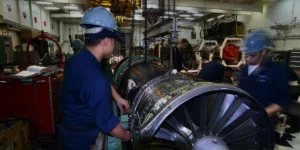Managing a business with dozens (possibly thousands) of assets is a time-consuming and complex operation. To keep costs low and ensure you’re getting the most out of your staff and equipment, you must be willing to evolve and invest in emerging technologies.
Here are three ways you can simplify the management process with a computerized maintenance management system (CMMS).
Locate and Transfer Items
When setting up a CMMS you must input all the necessary information into the system, and then update it whenever stock is moved, sold or transferred – if you’re using digital scanning equipment, the system will update automatically to reflect any changes. This allows you to access up-to-date information on-the-fly and instantly locate essential parts and items.
But what does this mean for maintenance management? The inability to locate stock/parts as and when they are required means that many businesses order more stock/parts to compensate. This is both expensive and unnecessary. Knowing the location of spare stock/parts makes maintenance quicker and more efficient, which not only reduces downtime and costs, but frees up staff to place more focus on revenue generating activities.
Devise an Advanced Scheduling Plan
With a CMMS, you can set-up alerts to remind your team when essential upgrades and maintenance tasks need to be carried out. There are two ways you can do this: task scheduling and stock alerts. While very similar, they each offer their own benefits.
Task scheduling is used for preventative maintenance – 51% of manufacturing facilities utilize a CMMS for this purpose. By following a schedule, you can reduce downtime of vital machinery and equipment. A good system will also ensure that accurate records can be easily accessed for items that need to be tested on a regular basis.
Stock alerts will alert you when more stock or parts need to be ordered or are going out-of-date. This allows to stay ahead of the game and focus more on preventative maintenance than the more wasteful corrective maintenance. Fundamentally, this will ensure you have an decent supply of stock/parts if you have an influx of orders or machinery stops working.
Simplify Record Keeping and Reporting
Whatever type of facility you operate, you will be bound by certain legal guidelines. These guidelines are enforced to protect employees from harm and ensure that equipment is adequately maintained. Both employees and employers can benefit from legal operating practices as they ensure equipment is fit-for-purpose and less likely to fail.
Automating your report systems means you can spend more time maintaining systems, rather than sifting through endless piles of paperwork. When you use a good quality CMMS all important information regarding your business – such as item codes, testing dates and compliance data – is readily available and can be consolidated into a report.
A CMMS may seem like an unnecessary expense. However, the preventative measures, increased efficiency and reduced operating costs will cover the investment and greatly improve day-to-day operations. In fact, the average CMMS user will recoup their costs within the first two weeks to two months of implementation.








